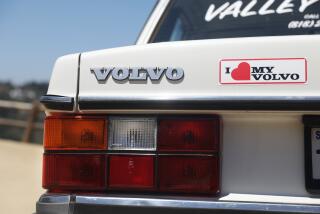Customize for the Masses
- Share via
When Ford Motor Co. and Web business IVillage.com decided to show off the Women’s Lifestyle Vehicle they had been quietly developing, it was no coincidence they chose as their launch pad a trade show best known for hairy-chested trucks and low-slung street rods.
The auto industry is changing--niche marketing and mass customization are the game now--and the Specialty Equipment Market Assn. show, held each November in Las Vegas, is the granddaddy of all niche marketing venues.
For the record:
12:00 a.m. Dec. 15, 1999 Dings and Scratches
Los Angeles Times Wednesday December 15, 1999 Home Edition Highway 1 Part G Page 2 Financial Desk 1 inches; 26 words Type of Material: Correction
Photo credit--Photographs last week of the Women’s Lifestyle Vehicle presented by Ford Motor Co. and IVillage.com should have been credited to the Specialty Equipment Market Assn.
The annual SEMA event is not for consumers. Unlike the upcoming Los Angeles and Detroit car shows, it is open only to the trade. But it has blossomed into a major venue for auto makers and the thousands of aftermarket companies that provide motorists with equipment to soup up and dress up the vehicles they buy. Nearly a quarter of SEMA’s 3,692 member companies are based in Southern California.
Showing the Women’s Lifestyle Vehicle at the trade show made sense, said IVillage marketing executive David B. Fales, because although it is a prototype--you can’t buy it at a dealership--it was put together with parts and accessories readily available in the aftermarket. And it spent a week on view before thousands of parts makers, buyers and sellers--all looking for an edge in the $21.2-billion-a-year business of specializing and personalizing the millions of mainstream cars and trucks that the auto industry feeds into the system each year.
Indeed, it has been the success of SEMA in promoting the performance- and appearance-parts industry that has helped convince auto makers from Detroit to Tokyo to Stuttgart, Germany, that mainstream is mundane, that customers want to customize and that they will turn to the aftermarket if the factories won’t provide.
One result has been an increasingly niche-oriented market in recent years, with auto makers forming new alliances with the aftermarket to ensure a steady supply of quality parts that consumers can use to personalize their vehicles.
Testifying to that truth during the inaugural showing of a modestly modified Chrysler PT Cruiser at the show, DaimlerChrysler’s product planning and styling chief, Tom Gale, said the crew that worked up the concept--dubbed the GT Cruiser--added more power and a few new styling cues to the production version, which will go on sale in the spring as a 2001 model.
*
Auto makers refer to the process as “mass customization,” making thousands of copies of a dressed-up version of one of their production vehicles. But they also know that many auto enthusiasts aren’t satisfied with what the factory provides and are driven by the urge to put their own stamps on their cars and trucks.
“Now it’s up to the special-equipment market to follow our lead,” said Gale, urging SEMA’s parts and equipment makers to turn out scores of additional customizing and performance-enhancing products for the Cruiser, a four-door sedan that has been described as a modern interpretation, in four-fifths scale, of a 1930s delivery van.
It wasn’t all car makers at SEMA, although Ford, General Motors, Nissan, Honda and Toyota also used the show to display concept vehicles, customizing parts and future production models. In all, nearly 1,400 companies exhibited tens of thousands of products, ranging from custom wheels to pickup truck bed extenders, superchargers and leather upholstery kits. More than 800 new products were on display, and some of them are likely to end up as factory equipment on new cars and trucks in coming years.
For Ford, the show provided a forum to announce an unprecedented information-sharing arrangement in which it will begin supplying previously unavailable technical data about selected vehicles to SEMA members. The program, which will begin next year, will enable participating aftermarket companies to design and produce compatible customizing accessories and performance equipment directly from Ford’s specifications.
The program is aimed at helping the aftermarket deal with “the increasingly complex technology planned for future-generation vehicles,” SEMA President Chuck Blum said.
Ford already has dipped its toes in the water, supplying early versions of its new Focus to custom parts makers such as Newport Beach-based Wings West Inc., whose racy, lowered, big-wheeled version of the compact coupe drew thousands of visitors to its booth during the four-day SEMA show. The Wings West Focus, in fact, won the company and chief designer Bill Longfellow a “best use of aftermarket parts” design award from Ford. The plaque was handed to Longfellow by another top automotive stylist, J Mays, Ford’s vice president for design.
In its own booth, Ford displayed several mass-custom efforts, including the new Explorer SportTrac--the cab of an Explorer sport-utility vehicle mated to a short pickup bed--and several versions of its new Excursion, the largest SUV on the market. In fact, there were so many aftermarket-tweaked Excursions on display throughout the 1.5 million-square-foot convention center that one parts buyer exclaimed: “No wonder I can’t find one at a dealership. They’re all here!”
*
The Ford-IVillage women’s vehicle is a key example of how manufacturers and aftermarket companies can work together to produce vehicles that fill the ever-increasing special-needs niches in the auto market.
The vehicle, a Villager minivan donated by Ford’s Irvine-based Mercury unit, was fitted with more than a dozen items that female users of IVillage’s online Women’s Auto Center (https://www.ivillage/auto) said they wanted in the vehicle of their dreams.
The responses came from more than 600 women, Fales said, and included the practical as well as “some science-fiction stuff.”
“One woman asked for windows that you could tint at the touch of a button to provide added security in bad parts of town,” he noted.
Fales said Ford approached IVillage about the project.
“They want to market to women, and we have 7 million distinct visitors per month to our site, and the ability to engage in two-way dialogue with them.”
Ford had already signed on as exclusive sponsor of IVillage’s Women’s Auto Center site, which launched in May, and used the site to ask women about the kinds of features they want on their vehicles. The result “validates what we’ve been hearing through our other research,” said Linda Lee, manager of Ford’s 4-year-old Women’s Marketing and Product Office.
The timetable for showing the van in public was moved up a few months when SEMA’s women’s marketing council made its own call to IVillage about the possibility of obtaining information about what women want in their cars.
So the Villager was turned over to SEMA along with IVillage’s list of items that its female car site users had said they’d like to see in their next vehicle. SEMA sent the list to its members and the equipment that poured in was installed on the van.
That equipment included an elastic cargo net stretched over the factory-supplied rear parcel shelf to keep small items like purses, diaper bags and toys from rolling around; a hands-free cellular phone linked with a pop-up laptop computer to let working moms stay in touch while waiting for the kids’ music lessons and soccer practices to end; stain-resistant carpeting that is easy to remove so spilled juice and ground-in French fries can be cleaned up; a television, VCR and electronic game system with dual controls to keep back-seat passengers entertained on trips; and seat warmers for added comfort on cold days.
Safety features included side-view mirrors with integral LED turn-signal indicators; a well-equipped emergency first-aid kit for repairing sports and schoolyard injuries; a satellite navigation system that displays electronic maps; a dash-mounted tire monitoring system to warn of leaks and uneven tire pressures that could affect handling; and a set of run-flat tires to eliminate worries about blowouts and tire-changing chores.
“I was really surprised by the interest in the women’s market and the awareness of so many of these companies of the need to start marketing things that suit women’s needs,” Fales of IVillage said after the show. “I was also quite surprised that while a lot of the accessories are readily available, the industry so far has failed to see their application to women’s needs.”
But displaying the van at SEMA illustrated how some of the custom touches on such vehicles can fire the imaginations of the auto makers themselves.
Ford Chief Executive Jac Nasser, for example, got his first glimpse of the women’s vehicle during an impromptu walk through the show one evening and was intrigued by the run-flat tires.
“Do women tell you that they would like to do away with the spare tire?” he asked Fales.
The issue, other Ford executives explained, is that Ford design chief Mays wants to use the larger tires and wheels popularized by aftermarket customizers on Ford production vehicles. But fitting oversized spares creates enormous storage and design problems. Eliminating them in favor of run-flat tires would solve a number of headaches.
It was easy to see the wheels turning as Nasser, Mays and a host of other corporate executives flocked around the tricked-out minivan.






